INSIDE
RACING
T E C H N O L O G Y
IRT Home
News Page
Contents Page
Newsletter &
Books
email Paul
Bruns' Eagle Mods
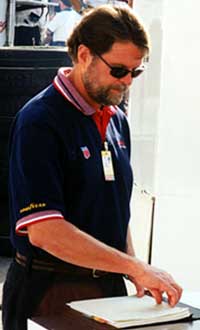 Swift
Engineering, located in San Clemente, Calif. south of Los Angeles,
is revered by U.S. road racers as a source of great racecars.
Twenty years ago most racers competing on American tracks had
to buy racecars designed and built in England and sold in this
country by an importer/distributor like Carl Haas. The David
Bruns-designed Swift DB-1 (DB for David Bruns' initials) Formula
Ford began racing late in 1983 and quickly eclipsed all the other
FF cars available. The British designers had always just shipped
their cars over here whenever they made one that fit American
rules. Bruns (shown in photo) actually did some engineering analysis
and designed a car just for American tracks and tires and drivers.
Swift
Engineering, located in San Clemente, Calif. south of Los Angeles,
is revered by U.S. road racers as a source of great racecars.
Twenty years ago most racers competing on American tracks had
to buy racecars designed and built in England and sold in this
country by an importer/distributor like Carl Haas. The David
Bruns-designed Swift DB-1 (DB for David Bruns' initials) Formula
Ford began racing late in 1983 and quickly eclipsed all the other
FF cars available. The British designers had always just shipped
their cars over here whenever they made one that fit American
rules. Bruns (shown in photo) actually did some engineering analysis
and designed a car just for American tracks and tires and drivers.
The distinctive characteristics of the DB-1 were a wide track, long wheelbase, and low frontal area. The result was the DB-1 would corner faster, reach higher top speeds, and was easier to drive than the other cars. All that for less than $16,000 without engine, the same as a new Lola.
The next Bruns design was a sleek Sports 2000 car, the DB-2. The DB-3 was a Formula Ford 2000, the DB-4 a Formula Atlantic racer, the DB-5 an updated Sports 2000, and the DB-6 a redesigned FF2000. In the early 90s Swift began to talk about making a "big car" which at the time meant a GTP sports car. Indy cars were languishing but the IMSA GTP races were exciting and had the support of auto makers like Porsche, BMW, Toyota, Ford, Chevrolet, and Nissan.
Hiro Matsushita won the Formula Atlantic championship in 1989 driving a Swift DB-4. He bought Swift Engineering in 1991 and provided the money to build a state-of-the-art wind tunnel, an indispensable tool for a "big car" designer. Typically, Bruns did some research and then designed his own wind tunnel rather than buying one from a known supplier. It was a costly project that strained the fledgling company.
In November of 1994 I visited Swift during the final stages of certification of the new wind tunnel. Bruns told me, "It's like deciding to build a house and then spending two years making a hammer." By that time the IMSA GTP series had declined and Indy car racing was prospering in spite of a nasty tiff between Tony George, president of the Indianapolis Motor Speedway, and CART owners.
Swift was run by a triumvirate of racers: Alex Cross, executive VP and chief operating officer; Jim Chapman, VP of manufacturing; and Bruns, VP for engineering. They decided to design and build an Indy car, but needed a successful CART team as a partner. Dan Gurney's All American Racers organization had shown everyone how difficult it was to design a new car without current data from a good driver in a competitive car.
Swift partnered with Newman-Haas racing and began to design an Indy car. The project bore fruit when Michael Andretti won the first CART race of the 1997 season at Homestead, Fla. driving the new Swift 007.i.
In April of 1998 problems with Newman-Haas forced a reorganization at Swift that elevated aerodynamicist, Mark Handford, to Technical Director. Bruns left Swift and went to work for Dan Gurney's All American Racers as Chief Designer. The latest mods to the AAR Eagle show Bruns' influence.
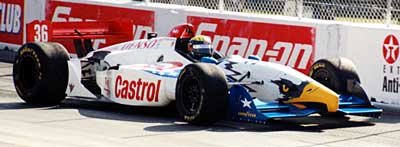
The fairing in front of the rear wheel is interesting. Tires on open-wheel cars create large flow fields that cause a lot of drag. This fairing is similar to one on Dallara's IRL car. The team keeps it covered in the pits so there are no detail photos. I've heard there are some interesting features inside the side pods but a request to see that received no enthusiasm.
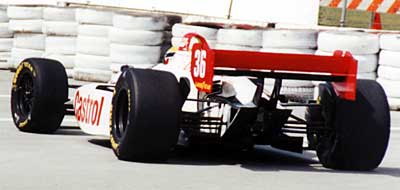
This photo shows a curved gearbox cover that continues the shape of the diffuser. The most interesting feature is the exhaust opening high on the engine cover seen just to the right of the left end plate on the rear wing.
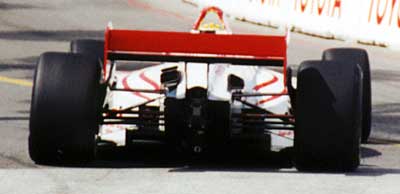
This view shows the exhaust opening just under the rear wing. I asked Bruns if he had placed both the turbo exhausts and exhaust from the two waste gates in this high position. He said only, "Yes." The smaller opening on the right side of the engine cover might exhaust the right-side waste gate while the larger opening on the left is the main turbo exhaust plus the left-side waste gate.
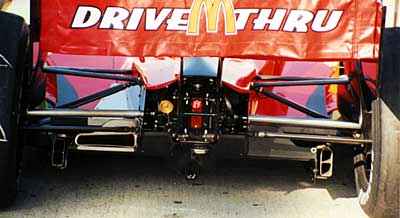
This rear view of the Reynard driven by Tony Kanaan shows the main turbo exhaust exiting over the left side of the diffuser where it might, under certain conditions help diffuser flow. The waste gate outlets are on each side of the diffuser and this is the space Bruns gains with his design. In the Eagle photo above you can see the sides of the diffusers are clean and there is more distance to the tire. The rules state the diffuser must be a maximum of 35 inches wide and 4 inches high. The tires have to clear the bodywork by 4 inches.
Current CART rules have been in place for several years and all the big gains have been made by the chassis engineers and teams. Small, expensive gains are all that's left. I think Bruns is exercising his mechanical packaging expertise here placing components in smaller spaces allowing a more extreme "coke bottle" shape at the rear. This leaves more room for the air flow around the rear tires lowering drag and providing less turbulent air to the rear wing.